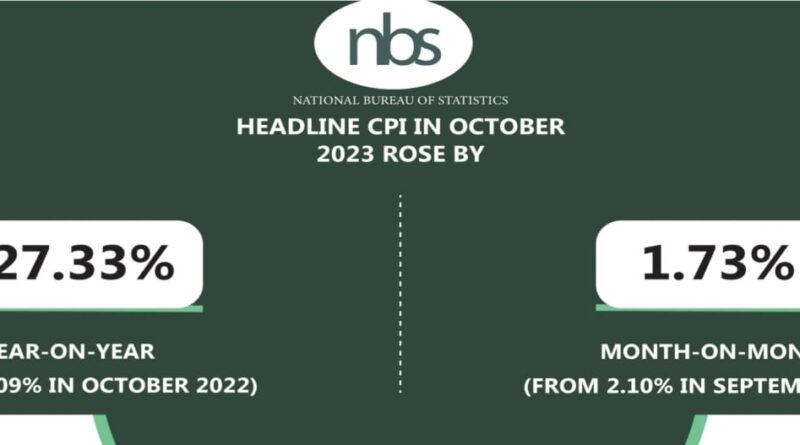Inflation in Nigeria rises to 27.33 percent in October -NBS.
According to the NBS, Nigeria’s annual headline inflation rate reached 27.33 percent in October 2023.
It was announced in Abuja on Wednesday in the NBS’s Consumer Price Index (CPI) and Inflation Report for October.
The research states that this is an increase of 0.61 percent from the 26.72 percent seen in September 2023.
The headline inflation rate for October was 21.24%, which is 6.24 percentage points more than the rate recorded in October 2022.
According to the research, higher prices for several goods and services in the overall index for October 2023 compared to the same period the previous year were to blame.
According to the report, these increases were seen mostly in the cost of housing, water, electricity, gas, and other fuels (4.57%) and food and nonalcoholic beverages (14.16%).
The remaining sectors are apparel and footwear (2.09%), transportation (1.78%), housing (1.37%), utilities (1.08%), education (1.08%), and healthcare (0.82%).
Also included were the percentages spent on “miscellaneous goods and services” (0.45%), “restaurants and hotels” (0.33%), “alcohol, tobacco, and drugs” (0.30%), “recreation and culture” (0.29%), and “communication” (0.29%).
In addition, the study added that, on a month-on-month basis, the headline inflation rate in October 2023 was 1.73 percent, which was 0.37 percent lower than the rate recorded in September 2023 at 2.10 percent.
It was stated that the rate of increase in the overall price level in October 2023 is lower than the rate of increase in the overall price level in September 2023.
The report indicated that the average CPI for the 12 months ending in October 2023 increased by 23.44% when compared to the average CPI for the preceding equivalent 12-month period.
This represents a rise of 5.57 percent compared to the 17.86 percent seen in October 2022.
According to the data, food inflation hit 31.52 percent in October on a year-over-year basis, 7.80 percent more than the inflation rate of 23.72 percent seen in October 2022.
It continued, “The rise in food inflation year over year is a result of increases in the prices of oil and fats, bread and cereals, fish, potatoes, yams and other tubers, fruits, meat, vegetables, milk, cheese, and eggs.”
The food inflation rate for October was 1.91 percent, down from September’s 2.45 percent reading but still over the 2023 average of 1.33 percent.
The average prices of fruits, oils, and fats, coffee, tea, chocolate, bread, and cereals all dropped from the previous month, the survey said.
Excluding the more volatile costs of agricultural goods and energy, the report found that “all items less farm produce and energy,” or core inflation, was 22.58 percent in October.
This is a rise of 5.12 percentage points from the 17.46% seen in October 2022.
The study elaborated, saying that the PMS was left out because the item had been “deregulated” by the elimination of subsidies.
Road passenger transport, medical services, air passenger transport, actual and imputed home rentals, pharmaceutical products, etc. were cited as having the largest price rises.
In October 2023, the NBS reported a monthly core inflation rate of 1.39 percent.
Compared to the 2.22 percent reported in September 2023, this is a 0.83 percent decrease, according to the data.
The annual inflation rate for the 12 months ending in October 2023 was 19.98 percent, 4.60 percentage points more than the annual inflation rate reported in October 2022 of 15.38 percent.
According to the data, the annual urban inflation rate was 29.29% in October, which is 7.66% higher than the annual rate of 21.63 reported in October 2022.
It stated, “The urban inflation rate was 1.81 percent in October, down from 2.24 percent in September 2023.” This is a decrease of 0.43 percent over the previous month.
According to the research, the annual rate of inflation in rural areas was 25.58 percent in October, up 5.01 percentage points from the 20.57 percent seen in October 2022.
The annual rate of inflation in rural areas was 1.67 percent in October 2023, down from September’s 1.96 percent.
According to the report’s profile study of the states, the annualised rate of inflation for all goods and services in October was 34.20 percent in Kogi, 31.44% in Rivers, and 31.33% in Lagos.
Headline inflation increased by 20.06 percent in Borno, 23.52 percent in Jigawa, and 24.47 percent in Sokoto, according to the report.
According to a report from October 2023, Yobe had the highest month-over-month inflation rates (3.72%), Jigawa came in second (2.85%), and Sokoto came in third (2.84%).
Kogi had the lowest month-over-month inflation rate at 1.01 percent, ahead of Edo at 1.05 percent and Kwara at 1.18 percent.
According to the survey, Kogi had the highest annual food inflation at 41.74 percent, followed by Kwara at 38.48 percent and Lagos at 37.37 percent.
It also noted that the annual increase in food inflation was lowest in the state of Borno (24.41%), followed by the states of Kebbi (24.90%), and Jigawa (25.10%).
However, according to the report, Yobe had the highest month-over-month food inflation rate at 5.35 percent, with Sokoto coming in second at 3.68 percent and Jigawa coming in third at 3.45 percent.
According to the report, Edo reported the lowest increase in month-over-month food inflation at 0.95 percent, with Katsina coming in second at 1.03 percent and Rivers coming in third at 1.10 percent.




